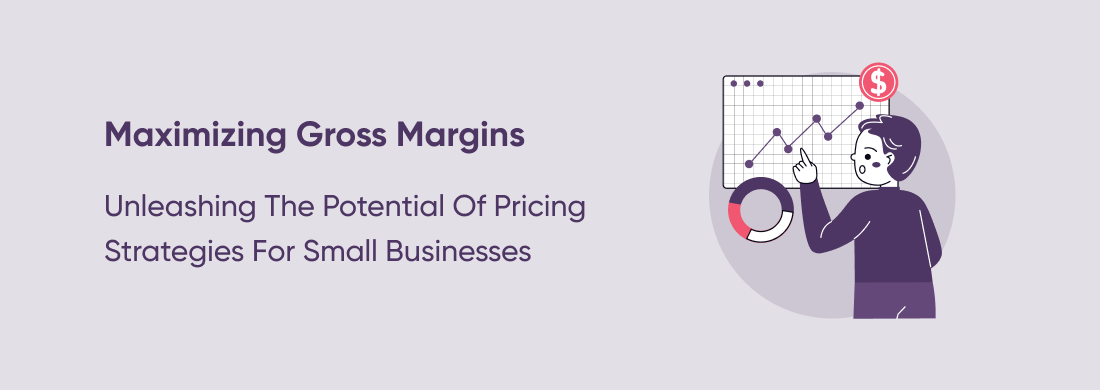Maximizing Gross Margins - Unleashing the Potential of Pricing Strategies for Small Businesses
Aug 12, 2023 | 16 Min Read


Jump to Sections
Stay updated
with our Blogs
We will keep you updated about our latest blogs
Share This Blog
An effective pricing strategy is crucial for small businesses to maximize gross margins. In this blog, we will explore the relationship between pricing strategies and the effect on gross margins, as well as the strategies small businesses can adopt to maximize their margins.
Understanding Gross Margins
Gross margins are an important financial metric that reflects the company’s financial performance and profitability. It is the proportion of revenue that exceeds the cost of goods sold. A strong gross margin indicates that the business can cover the direct costs, as well as having funds remaining to cover other expenses, such as operating costs and taxes.
Understanding gross margins is essential for managers to make informed decisions and evaluate the overall financial health of the business.
Different types of pricing strategies and their relation to gross margins
Gross margins are directly related to the pricing strategies adopted by the business. By setting optimal prices for their products and services, businesses can provide both competitive prices for customers and generate healthy profits.
The pricing strategy chosen by a business can impact the revenue, market share and profitability of the business. Some of the most common pricing strategies and how they impact gross margins are given below:
Cost-Based Pricing:
This is a relatively simple approach to the pricing of products and services offered by the company. It is calculated by adding the total cost of production with the desired profit margin.
Cost-Based pricing ensures that the business covers its expenses and achieves the desired gross margins.
However, this approach has several disadvantages. Cost-Based pricing requires an accurate estimate of the production costs, which can otherwise negatively impact the profitability of the business. It also does not consider market perception and willingness to pay the price determined by the business. This can also lead to missed opportunities if customers are willing to pay a higher price, leading to lower gross margins.
Value-Based Pricing:
This is a relatively complex pricing strategy that relies on the perceived value of the products or services to the customer. Businesses can reap higher gross margins if customers see a high value proposition and are willing to pay premium prices for the offerings.
Value-based pricing aligns prices with customer preferences, encouraging product differentiation and development of strong brand loyalty.
However, businesses must effectively communicate the value proposition to customers and determine customer preferences for this strategy to be successful in maximizing gross margins.
Competitor-Based Pricing:
With Competitor-Based pricing, businesses evaluate the prices being offered by competitors and set prices in line with, slightly above or below competitors. This may lead to lower gross margins if competitor prices are suboptimal and can also result in price wars, eroding profitability. Furthermore, it ignores unique value propositions and differentiating factors that could attract customers that are willing to pay higher prices.
Dynamic Pricing:
With the advent of technology and artificial intelligence, businesses can monitor customer demand, market conditions and customer behavior in real-time, allowing prices to be adjusted constantly, to maximize gross margins. This is commonly seen with airline tickets becoming pricey during peak traveling seasons or cheaper when planes are about to take-off with fewer passengers.
Pricing strategies require immense evaluation before and after implementation, to gauge the effect they have on gross margins. Businesses must remain agile in their pricing strategies as market conditions, customer preferences, demand and cost structures constantly evolve. Careful evaluation of all these factors can lead to informed pricing decisions that can positively impact on their gross margins.
Want to learn about the next steps for growing your business ?
Variables Affecting Pricing Strategy
There are several factors that businesses need to consider when determining the optimal selling price for their products and services. Understanding these variables can help make informed pricing decisions. Some key variables to consider are:
Cost of Goods Sold:
This is the cost of acquiring or producing the product. The selling price should be sufficient to cover the direct and indirect production/procurement costs, while leaving room for a reasonable profit margin. Also, by optimizing the cost structure and improving operational efficiencies, businesses could increase their margins due to the reduced costs.
Customer Analysis:
Understanding customers’ willingness to pay, perception of the product, their preferences, and market demand can help in aligning prices with customer expectations. Pricing products too low may give the perception of inferior quality, leading to a lack of sales and a deteriorating brand image.
Competitor Pricing:
Considering competitor pricing, product differentiation and customer perception of competitor products can also influence pricing decisions.
Product Differentiation:
Products with a unique selling point can command premium pricing. Businesses must adjust prices based on customer perceptions of the product offerings and value proposition.
Market Conditions and Trends: Pricing strategies are also influenced by economic conditions, changing customer preferences, fluctuations in supply and demand, as well as seasonal trends. Offering discounted prices during periods of lower demand can stimulate revenue, while margins could increase during periods of higher demand.
Customer Segmentation:
Different segments of the market have different perceptions and sensitivities to prices. Businesses could offer customized prices to different segments, maximizing gross margins.
Marketing and Distribution Strategy:
Pricing should be aligned with long-term objectives. A business could consider branding itself as a low-cost provider or a premium brand, and all marketing activities should be aligned to portray the same.
The choice of distribution channels can also affect pricing strategy. Different channels have different cost structures, and this should be considered when determining pricing strategy.
Legal Considerations:
Pricing decisions must be taken after consideration of any regulations that businesses must adhere to.
Careful analysis of these variables enables businesses to develop pricing strategies that are well-aligned with market dynamics, financial goals and customer preferences. This allows businesses to maximize profits and sustain growth in challenging times.
Strategies to Maximize Gross Margins
There are several strategies and factors that need to be considered to maximize gross margins. These are:
Effectively communicating value to customers:
Communicating value to customers is essential to increase gross margins. Customers must understand the benefits, advantages, and features of the offer to justify higher prices and to reduce the focus on price as the main purchasing factor. Businesses should provide detailed product descriptions, provide testimonials or reviews, or even allow free demos to allow the customer to experience the product or service before purchasing.
Price Elasticity:
Price elasticity is the sensitivity of consumer demand to a change in price. This can be determined by conducting market research to gauge customer responses to different prices, analysis of historical sales trends or using price optimization tools to identify the most profitable options. By determining price elasticity, businesses can make informed decisions on prices to maximize gross margins.
Upselling and Cross-Selling:
This is a technique to increase the average transaction value by encouraging the purchase of complementary or upgraded products or services without significantly increasing production costs. Businesses can offer products or services as a bundle, provide product recommendations based on customer preferences or suggest premium options during the purchasing process. Upselling and Cross-Selling techniques can boost gross margins and increase the value provided to customers.
Promotions:
Limited time discounts and promotions can be used strategically to ensure healthy gross margins. This can be successfully done by limiting the frequency of discounts to ensure customers value perception is not undermined, bundling products such that higher margin products offset ones with lower margins, value added promotions which do not directly affect the price of the product such as a gift with every purchase, and volume-based discounts. Businesses should analyze these techniques to ensure gross margins do not erode and healthy margins are maintained.
Cost Optimization:
Entrepreneurs should conduct a thorough analysis of their cost structures and identify areas for cost reduction without compromising on customer experience. With higher sales volumes, businesses can achieve economies of scale, reducing the cost per unit produced. Similarly, negotiating favorable terms with suppliers can lead to lower procurement costs, exclusive deals and discounts, stimulating gross margins. Strategic partnerships with complementary businesses can lead to cost sharing opportunities, further driving gross margins.
Moreover, by establishing an online presence, especially through e-commerce platforms, businesses can gain access to cost-effective distribution channels.
Price Optimization:
To maximize gross margins, businesses should leverage advanced pricing analytics and software to analyze historical and current market data, customer behavior, and competitor pricing to make informed decisions. Developing pricing mechanisms such as dynamic pricing, price segmentation and premium pricing, businesses can ultimately maximize their margins.
How Accountimize Can Help
Accountimize is a trusted small business accounting and bookkeeping service provider. Our experienced team of CPAs will assist your business to analyze financial statements, develop effective pricing strategies, and identify opportunities for cost-savings to maximize gross margins.
Contact Accountimize today and allow us to be your trusted partner in driving financial success and taking your business to new heights.
Book a Discovery call


Stay updated
with our Blogs
We will keep you updated about our latest blogs



